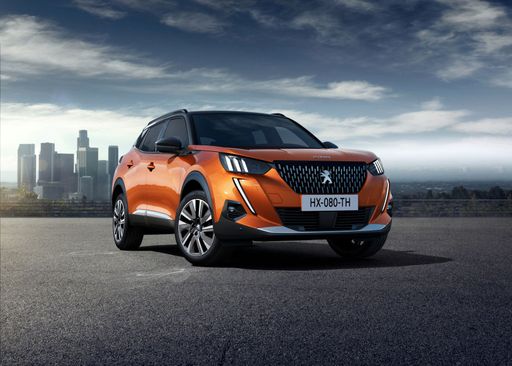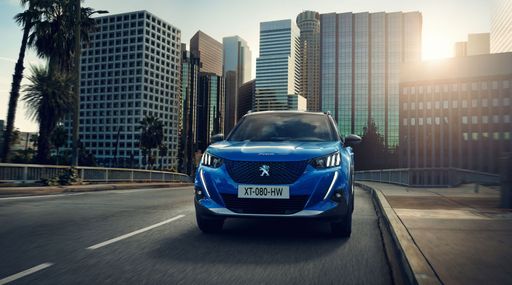Peugeot 2008 VS Renault Trafic Bus – Specs, Efficiency & Price Comparison
Which model is the better choice – the Peugeot 2008 or the Renault Trafic Bus? We compare performance (156 HP vs 150 HP), boot capacity (434 L vs ), efficiency (15.50 kWh5 L vs 6.80 L), and of course, the price (23800 £ vs 38200 £).
Find out now which car fits your needs better!
The Peugeot 2008 (SUV) is powered by a Petrol, Electric or Petrol MHEV engine and comes with a Manuel or Automatic transmission. In comparison, the Renault Trafic Bus (Bus) features a Diesel engine and a Manuel gearbox.
When it comes to boot capacity, the Peugeot 2008 offers 434 L, while the Renault Trafic Bus provides – depending on what matters most to you. If you’re looking for more power, you’ll need to decide whether the 156 HP of the Peugeot 2008 or the 150 HP of the Renault Trafic Bus suits your needs better.
There are also differences in efficiency: 15.50 kWh5 L vs 6.80 L. In terms of price, the Peugeot 2008 starts at 23800 £, while the Renault Trafic Bus is available from 38200 £.
Compare all the key specs now and find out which model fits your lifestyle best!
Peugeot 2008
The Peugeot 2008 stands out in the compact SUV market with its blend of striking design and practical functionality. It offers a comfortable ride with a sophisticated interior that exudes quality, making it ideal for both urban commutes and longer journeys. The model's efficient performance and range of modern features further enhance its appeal to a diverse range of drivers.
details @ media.stellantis.com
@ media.stellantis.com
 @ media.stellantis.com
@ media.stellantis.com
 @ media.stellantis.com
@ media.stellantis.com
 @ media.stellantis.com
@ media.stellantis.com
Renault Trafic Bus
The Renault Trafic Bus is a versatile and spacious option for those needing to transport multiple passengers comfortably. With its modern design and practical features, it is well-suited for both business and leisure purposes. Its efficient engine and smooth handling make it a reliable choice for long journeys.
details

|
|
|
|
|
Costs and Consumption |
|
|---|---|
|
Price
23800 - 38300 £
|
Price
38200 - 51100 £
|
|
Consumption L/100km
5 - 6.2 L
|
Consumption L/100km
6.8 - 7.2 L
|
|
Consumption kWh/100km
15.50 kWh
|
Consumption kWh/100km
-
|
|
Electric Range
406 km
|
Electric Range
-
|
|
Battery Capacity
51 kWh
|
Battery Capacity
-
|
|
co2
0 - 140 g/km
|
co2
179 - 188 g/km
|
|
Fuel tank capacity
44 L
|
Fuel tank capacity
80 L
|
Dimensions and Body |
|
|---|---|
|
Body Type
SUV
|
Body Type
Bus
|
|
Seats
5
|
Seats
8 - 9
|
|
Doors
5
|
Doors
4
|
|
Curb weight
1263 - 1623 kg
|
Curb weight
2031 - 2321 kg
|
|
Trunk capacity
434 L
|
Trunk capacity
-
|
|
Length
4304 mm
|
Length
5080 - 5480 mm
|
|
Width
1770 mm
|
Width
1956 mm
|
|
Height
1523 mm
|
Height
1973 - 1974 mm
|
|
Payload
407 - 460 kg
|
Payload
749 - 982 kg
|
Engine and Performance |
|
|---|---|
|
Engine Type
Petrol, Electric, Petrol MHEV
|
Engine Type
Diesel
|
|
Transmission
Manuel, Automatic
|
Transmission
Manuel
|
|
Transmission Detail
Schaltgetriebe, Automatikgetriebe, Automat. Schaltgetriebe (Doppelkupplung)
|
Transmission Detail
Schaltgetriebe
|
|
Drive Type
Front-Wheel Drive
|
Drive Type
Front-Wheel Drive
|
|
Power HP
101 - 156 HP
|
Power HP
110 - 150 HP
|
|
Acceleration 0-100km/h
8.3 - 10.9 s
|
Acceleration 0-100km/h
13.6 - 16.5 s
|
|
Max Speed
150 - 206 km/h
|
Max Speed
161 - 174 km/h
|
|
Torque
205 - 270 Nm
|
Torque
300 - 350 Nm
|
|
Number of Cylinders
3
|
Number of Cylinders
4
|
|
Power kW
74 - 115 kW
|
Power kW
81 - 110 kW
|
|
Engine capacity
1199 cm3
|
Engine capacity
1997 cm3
|
General |
|
|---|---|
|
Model Year
2023 - 2025
|
Model Year
2023 - 2024
|
|
CO2 Efficiency Class
D, A, E, C
|
CO2 Efficiency Class
G
|
|
Brand
Peugeot
|
Brand
Renault
|
Peugeot 2008
Introducing the New Peugeot 2008: A Blend of Style and Innovation
The new Peugeot 2008 is a standout vehicle in the compact SUV segment, combining dynamic styling with cutting-edge technology. Known for its versatility and impressive features, the 2008 offers more than just good looks. Let's delve into the technical nuances and innovative aspects that make this model a preferred choice among contemporary SUVs.
Engine Options and Performance
The Peugeot 2008 offers a variety of powertrain options to suit different driving needs. Whether you opt for the petrol Mild-Hybrid engine or the fully electric variant, each version delivers a unique driving experience. The engine range includes 1.2-litre petrol engines boasting up to 156 PS and an electric motor option offering the same power. With CO2 emissions ranging from 0 to 129 g/km and a top speed between 150 km/h to 206 km/h, the 2008 ensures efficiency without compromising on performance.
Advanced Technology and Features
The Peugeot 2008 is packed with innovative technology designed to enhance the driving experience. It includes an advanced infotainment system integrated with cutting-edge connectivity solutions. Drivers can enjoy a seamless connection to their digital life with features like smartphone compatibility, real-time navigation, and a configurable digital driver's display. Additionally, advanced driver-assistance systems provide enhanced safety and convenience, making every drive more reassuring.
Electric Powertrain: Embracing the Future
For eco-conscious drivers, the e-2008 variant offers an impressive electric range of 343 to 406 km, thanks to its efficient 46 to 51 kWh battery. With a consumption of just 15.5 to 15.9 kWh/100km, it stands out as an environmentally friendly option. The smoothness of its automatic transmission ensures a comfortable ride, while instant torque from the electric motor provides a thrilling driving experience.
Design and Practicality
Beyond its performance, the Peugeot 2008 flaunts a contemporary design that is both sporty and elegant. Its compact dimensions (4304 mm length, 1770 mm width, 1523 mm height) are accentuated by a streamlined profile and distinctive full LED headlights. Practicality isn't sacrificed either, with a spacious boot capacity of 434 litres and intelligent layout offering ample space for passengers and cargo.
Customisation and Comfort
The interior of the 2008 is crafted to offer comfort and luxury. With options ranging across different trim levels such as Allure, GT, and Style, customers can tailor their vehicle to their personal taste and requirements. High-quality materials and ergonomic seating ensure both driver and passengers travel in comfort, making even the longest journeys pleasant.
Value for Money
The Peugeot 2008 offers competitive pricing from €27,050 to €44,600, catering to a wide audience. With monthly costs ranging from €956 to €1,049 and an efficient cost per kilometre, it presents significant value for money. Its combination of style, technology, and practicality means it’s more than just a vehicle; it’s a smart investment.
In summary, the Peugeot 2008 stands as a remarkable choice in the SUV market, seamlessly blending style, technology, and efficiency. Whether you prioritise eco-friendliness, driving pleasure, or advanced tech features, the 2008 delivers on all fronts, making it a top contender for modern drivers.
Renault Trafic Bus
A Glimpse into the Renault Trafic Bus: An Icon of Versatility and Innovation
Amongst the plethora of vans designed for both business and leisure, the Renault Trafic Bus stands out as an exemplar of functionality, innovation, and style. Let's delve into what makes the Renault Trafic Bus a popular choice in the UK and across Europe, particularly focusing on its technical specifications and state-of-the-art features.
Performance Dynamics: Power Under the Hood
The Renault Trafic Bus, a staple in Renault's fleet, is driven by a robust diesel engine configuration with power outputs ranging from 110 PS to a formidable 170 PS. The diesel engines combine efficiency and power, offering torque figures between 300 to 380 Nm, ensuring smooth power delivery and capable load hauling.
Drivers can choose between manual and automatic transmissions, both designed to complement the Trafic's front-wheel-drive system. This flexibility ensures that drivers experience enhanced driving comfort whether they are navigating urban roads or cruising on the motorway.
Efficiency Meets Economy
The Trafic Bus showcases impressive fuel economy with consumption figures ranging from 6.8 to 7.2 litres per 100 kilometres. This efficiency is crucial for businesses aiming to minimise operational costs and for families seeking budget-friendly travel options.
With a generous fuel tank capacity of 80 litres, the Renault Trafic Bus is built to cover long distances with fewer fuel stops, making it an ideal choice for long haul journeys.
Technological Innovations and Comfort
The Trafic Bus isn't just about robust performance. Renault has integrated a suite of technological innovations designed to enhance driver and passenger comfort. Its cabins are equipped with the latest infotainment systems and safety technologies, providing an optimal blend of comfort and convenience.
The various trims, such as Life, Start, Spaceclass, and their respective EDC variants, cater to different needs and preferences, ensuring that customers can find the perfect configuration for their requirements.
Design and Dimensions: Space for Every Purpose
Space and versatility are at the heart of the Trafic Bus design. With its dimensions ranging from a length of 5080 to 5480 mm, and a width of 1956 mm, this vehicle offers ample room for passengers and cargo alike. The height stands between 1973 and 1974 mm, ensuring that even taller individuals can travel comfortably.
With seating for up to eight people and a payload capacity between 730 to 1010 kg, the Trafic Bus can transform seamlessly between a people-mover and a goods carrier.
Environmental Considerations
Renault has engineered the Trafic Bus with environmental responsibility in mind. The CO2 emissions range from 178 to 190 g/km, which, while modest for its class, aligns with the efficiency and performance goals set for this versatile vehicle. The CO2 efficiency class is rated as 'G', offering transparency in its environmental impact profile.
Conclusion: A Leader in Its Class
The Renault Trafic Bus continues to lead its segment through a blend of power, efficiency, and technological advancements. Whether it's for commercial transport or family adventures, the Trafic offers a reliable and adaptable solution, setting a high standard for multi-purpose vehicles.
For those seeking a distinguished blend of utility and comfort, the Renault Trafic Bus emerges as an exceptional choice, promising performance and innovation on every journey.
The prices and data displayed are estimates based on German list prices and may vary by country. This information is not legally binding.
